
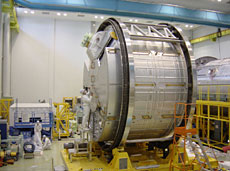
Kibo Experiment Logistics Module Pressurized Section
Q. You are a crew member of the space shuttle mission 1 J/A (also known as STS-123), scheduled for launch in 2008. What are the objectives of the mission?
The primary objective is to begin assembly of the Japanese Experiment Module "Kibo". Kibo consists of five parts: the Pressurized Module (PM), where astronauts stay and conduct experiments; the Exposed Facility (EF) and the Experiment Logistics Module Exposed Section (ELM-ES), for conducting experiments in outer space; the Experiment Logistics Module Pressurized Section (ELM-PS), for storing payloads and experiment materials; and a robotic arm, the Remote Manipulator System (JEMRMS), which will be attached to the pressurized module to support maintenance activities. These modules will be delivered to the International Space Station in three space shuttle missions. The 1 J/A mission is the first one, with the primary objective of attaching the ELM-PS to the space station. The Japanese-built module will open its doors for operations in space for the first time, ready for crew members to start work. Kibo assembly is finally about to begin.
We will also transport and attach a small robot, Canada's Special Purpose Dexterous Manipulator(SPDM), to the Canadian-built robotic arm, which was installed on the ISS in 2001. It's called a small robot, but SPDM is the size of an automobile, and its assembly and installation will be very difficult. The Station Shuttle Power Transfer System (SSPTS), first used during the STS-118 mission in August 2007, provides electrical power from the ISS to the space shuttle, extending the time the shuttle can be docked to the space station. During our 16-day flight, the shuttle will be docked to the ISS for 10 days, which will be the longest docked mission so far.
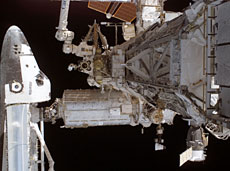
Space Shuttle docked to the International Space Station (courtesy of NASA)
My primary duty on the 1 J/A mission is to attach the Kibo module component ELM-PS to the space station by operating the space shuttle's robotic arm. The main purpose of the STS-87 mission was to validate the tools and procedures for the assembly of the ISS, whereas 1 J/A is all about assembly. Four space walks (also known as extravehicular activities, or EVAs) are planned for the mission, and I will support them in various ways, including operating the robotic arm. I will also support the pilot and the commander in docking the space shuttle to the ISS. The operation of the robotic arm and the docking are both new challenges for me.
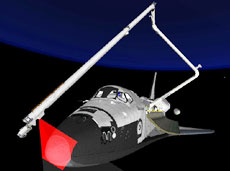
OBSS - the Orbiter Boom Sensor System (courtesy of NEPTEC)
Q. Very sophisticated maneuvers are required for the operation of the robotic arm. What has the training been like?
I've been spending a lot of time training on the simulator. The robotic arm will be used for docking the Kibo module to the ISS and also for inspecting for damage to the heat-resistant tiles on the shuttle and the reinforced carbon-carbon on its wings. I'm also training to operate the Orbiter Boom Sensor System, which will be attached to the end of the robotic arm to inspect the space shuttle's exterior, as well as having virtual realty training for EVA support.
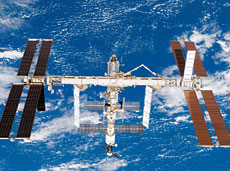
International Space Station under construction (courtesy of NASA)
A great benefit of the ISS is that it's a permanent facility in space, where people can live and work. The facility enables us to conduct long-term space experiments and to study how outer space affects human bodies. Such research will not only give us valuable biochemical data for future human flights to the Moon and beyond, but will also be useful in medical science on Earth. For example, calcium loss in bones and cosmic radiation are two critical problems for humans in space, but finding solutions to these problems will advance medicine on Earth as well. Apart from such scientific and technological applications, we'll also be able to carry out educational and cultural activities, such as the Teacher-in-Space project with Astronaut Barbara Morgan on the STS-118 mission. This is another benefit of the ISS.
Once Kibo is linked to the ISS and is operational, people in Japan will benefit from various types of information that will come from space. Although the Japanese media tends to cover human space activity only once every few years when Japanese astronauts go to space, with Kibo in space , there will be news from Kibo available daily. I think it's very exciting that the Japanese people will become more familiar with space.
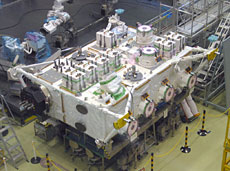
Kibo Exposed Facility
Q. What kind of space experiments are you interested in?
I studied fluid dynamics, so I'm interested in fluid experiments in the Kibo Pressurized Module. The space environment is very different from the environment on Earth, so I'm looking forward to studying fluid phenomena in space. I'm anticipating that phenomena caused by surface tension will one day be explained, which will contribute greatly to the development of new materials in space.
Also, Kibo has the Exposed Facility, which will enable us to conduct experiments directly in outer space, outside the space station. The high-vacuum space environment will facilitate new types of research in space technology development, Earth observation, and astronomical observation. Although there are other experiment modules on the ISS, from the United States and Europe for instance, only the Japanese module can accommodate extravehicular experiments. Naturally, this has been receiving worldwide attention. Since I majored in astronomy, I'm especially interested in astronomical observation from space. During my space-shuttle flight, I'm looking forward to taking pictures of stars and observing the Sun from the ISS as an amateur astronomer.